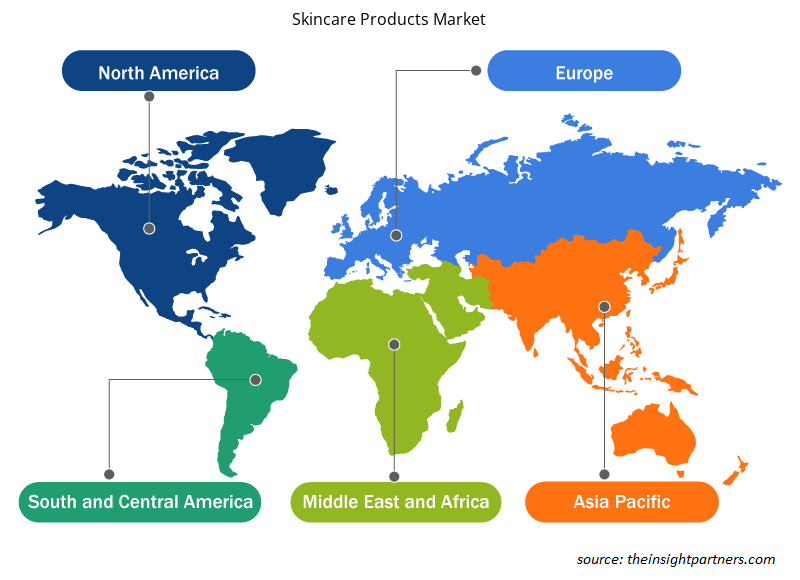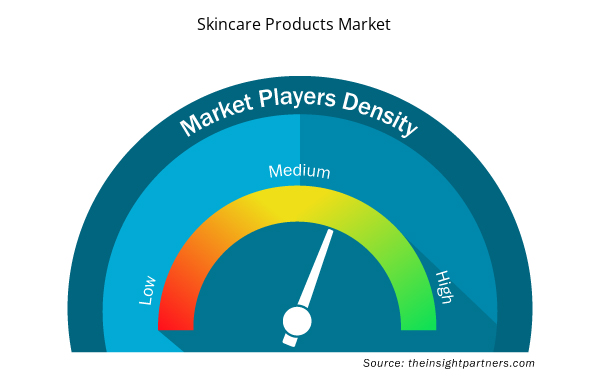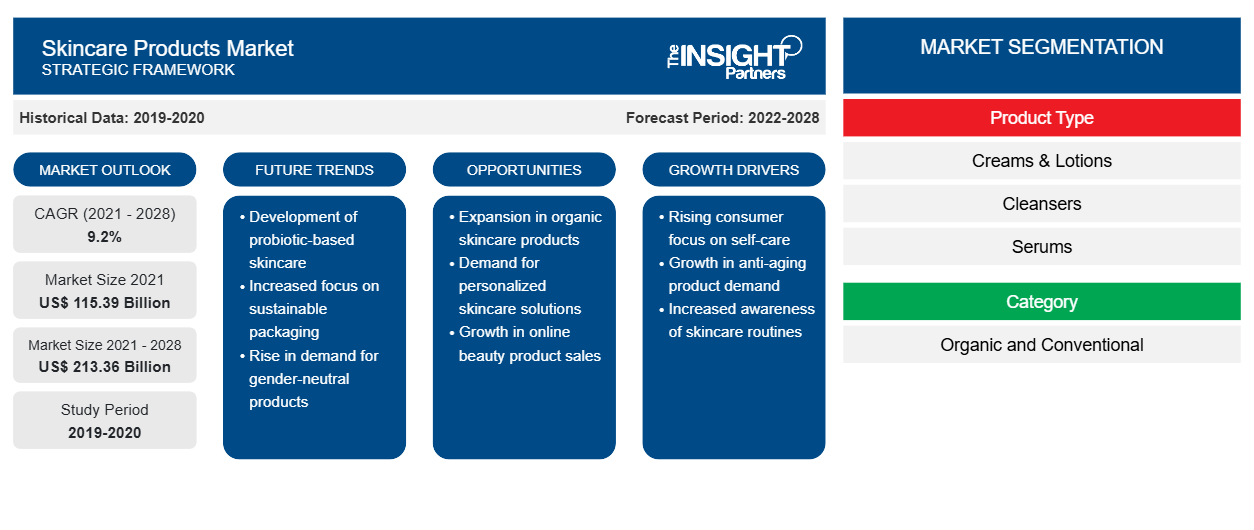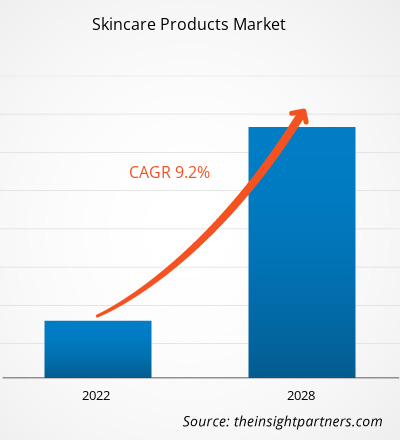2021 年护肤品市场规模价值 1153.8646 亿美元,预计到 2028 年将达到 2133.6309 亿美元。预计 2021 年至 2028 年的复合年增长率为 9.2%。
护肤品是一系列有助于保持皮肤完整性、提高吸引力和缓解皮肤病的产品。这些产品涂在皮肤上可防止过早衰老、痤疮和黑斑。护肤品包括滋养和改善皮肤质量的面霜、乳液和粉末。这些产品经常被男性和女性用于各种目的,例如保湿、补水和清洁。近年来,有机和草本护肤品很受欢迎。这是因为人们意识到合成化学物质对皮肤的有害影响。来自天然来源的成分,如叶提取物和根提取物,对皮肤是安全的,因为它们没有有害影响。
2020 年,亚太地区占据了全球护肤品市场的最大份额,预计在预测期内将大幅增长。亚太地区是最大的个人护理和美容产品市场之一。该地区的人们非常注重皮肤护理,喜欢改善皮肤的产品。人们认为护肤品可以增强皮肤的强度和弹性,改善干燥和受损皮肤的外观,使皮肤柔软、有弹性、无皱纹。因此,该地区个人护理行业的增长和对为皮肤提供功能性益处的产品的需求增加是推动亚太地区护肤品市场发展的关键因素。
定制此报告以满足您的需求
您可以免费定制任何报告,包括本报告的部分内容、国家级分析、Excel 数据包,以及为初创企业和大学提供优惠和折扣
- 获取此报告的关键市场趋势。这个免费样品将包括数据分析,从市场趋势到估计和预测。
COVID-19 疫情对护肤品市场的影响
由于全国范围内的封锁、企业停工和供应链中断,COVID-19 疫情影响了许多行业。疫情对护肤品市场的影响好坏参半。最初,由于封锁和企业停工,制造商遭受原材料和劳动力短缺的困扰,影响了他们的生产和供应。
此外,许多国家都接种了疫苗,政府也放宽了对制造业和贸易的限制。预计这些因素将在预测期内推动护肤品市场的发展。因此,COVID-19 疫情对护肤品市场产生了重大影响。
市场洞察
抗衰老产品消费不断增长
年轻和年长消费者对外表的意识日益增强,促进了对抗衰老护肤品的需求。消费者对与年龄相关的皮肤问题(如细纹、皱纹和皮肤暗沉)的认识不断提高,再加上他们越来越愿意花钱购买有助于展现皮肤年轻的产品,预计将推动市场的发展。抗衰老面霜和乳液在个人生活中起着至关重要的作用,有助于保持年轻的光泽和保湿。一些特殊配方的产品有助于面部皮肤保持水分、紧致和弹性,从而防止皱纹和细纹。人们非常关心自己的面部外观,并不介意在这些产品上花费巨额资金,这是推动该细分市场发展的关键因素。
此外,随着人们对动物福利和环境的日益关注,许多消费者选择无残忍产品,这增加了对护肤品中融合纯素或植物成分的需求。新产品的推出和创新预计将推动市场的发展。例如,2019 年 1 月,Drunk Elephant 推出了 A-Passioni 纯素抗皱霜,采用纯素和无麸质成分,可恢复肌肤年轻外观。虽然抗衰老产品通常由百货商店分销,但专卖店让它们更容易买到,也更广泛地供应。这些产品还通过网上商店、沙龙、水疗中心、专业零售店和电视直销广告(如电视购物广告和家庭购物频道)销售。
产品类型洞察
根据产品类型,护肤品市场分为面霜和乳液、清洁剂、精华液和其他。在预测期内,面霜和乳液占据了全球护肤品市场的最大份额。乳液和面霜是用于保持皮肤湿润的护肤品。这两种产品都是由油和水混合而成的。然而,油和水的含量百分比是有区别的。在乳液中,油滴混合在水中,而在面霜中,水滴混合在油中。
此外,面霜还有多种用途,如去除晒黑、亮白、减少油脂、去除黑眼圈和去除粉刺。乳液用于滋养皮肤,防止晒伤和晒黑。因此,这两种产品在用户中都获得了极大的关注,预计在预测期内将推动该细分市场的市场增长。
类别洞察
根据类别,护肤品市场分为有机护肤品和传统护肤品。在预测期内,传统护肤品在全球护肤品市场中占有较大的份额。传统护肤品通常由合成物质组成,例如对羟基苯甲酸酯、三氯生、甲醛和苯氧乙醇。它们是实验室中开发的潜在刺激性和致敏性成分。合成化学品对人体皮肤、动物和植物有害。此外,传统护肤品的生产会排放大量污染物,在地球上留下负碳足迹,从而阻碍该细分市场的增长。然而,传统护肤品的易得性和低成本正在推动护肤品市场的增长。
分销渠道洞察
根据分销渠道,护肤品市场细分为超市和大卖场、专卖店、在线零售和其他。预计在预测期内,在线零售部门的复合年增长率将最快。在线零售是增长最快的分销渠道之一,因为它购物和产品配送方便。网上零售店提供种类繁多的产品和大幅折扣。此外,消费者可以方便地远程购买理想的产品。此外,送货上门服务吸引了许多消费者通过电子商务门户购物。此外,这些网站提供全面的产品信息和用户评论,帮助买家比较产品并做出明智的决定。在 COVID-19 大流行期间,在线零售渠道因提供送货上门服务而广受欢迎。预计这一因素将在不久的将来推动在线零售领域的护肤品市场增长。
护肤品市场区域洞察
Insight Partners 的分析师已详尽解释了预测期内影响护肤品市场的区域趋势和因素。本节还讨论了北美、欧洲、亚太地区、中东和非洲以及南美和中美洲的护肤品市场细分和地理位置。

- 获取护肤品市场的区域特定数据
护肤品市场报告范围
| 报告属性 | 细节 |
|---|---|
| 2021 年市场规模 | 1153.9亿美元 |
| 2028 年市场规模 | 2133.6亿美元 |
| 全球复合年增长率(2021 - 2028) | 9.2% |
| 史料 | 2019-2020 |
| 预测期 | 2022-2028 |
| 涵盖的领域 | 按产品类型
|
| 覆盖地区和国家 | 北美
|
| 市场领导者和主要公司简介 |
|
护肤品市场参与者密度:了解其对业务动态的影响
护肤品市场正在快速增长,这得益于消费者偏好的不断变化、技术进步以及对产品优势的认识不断提高等因素导致的终端用户需求不断增加。随着需求的增加,企业正在扩大其产品范围,进行创新以满足消费者的需求,并利用新兴趋势,从而进一步推动市场增长。
市场参与者密度是指在特定市场或行业内运营的企业或公司的分布情况。它表明在给定市场空间中,相对于其规模或总市场价值,有多少竞争对手(市场参与者)存在。
在护肤品市场运营的主要公司有:
- 大号
免责声明:上面列出的公司没有按照任何特定顺序排列。

- 了解护肤品市场顶级关键参与者概况
最终用户见解
根据最终用户,护肤品市场分为男性、女性和其他。在预测期内,男性市场预计将以全球护肤品市场中最快的复合年增长率增长。男性人口对良好卫生和定期梳洗的意识不断增强、产品发布不断增加、名人代言不断增加以及可支配收入不断增长,这些都是推动男性护肤品市场增长的因素。此外,男性对改善外表的意愿和人均收入的增长预计将提振男性人群的个人护理产品销售,这有望在预测期内进一步支持市场增长。
护肤品市场的主要参与者包括欧莱雅集团、拜尔斯道夫、资生堂株式会社、宝洁、联合利华、喜马拉雅健康公司、Lotus Herbals、VLCC Wellness、雅芳产品和强生服务公司。这些参与者致力于开发创新产品以满足新兴的消费趋势。此外,他们还参与并购、业务扩张和合作,以扩大其全球市场份额。
报告亮点
- 护肤品市场不断发展的行业趋势,帮助参与者制定有效的长期战略
- 发达市场和发展中市场采用的业务增长战略
- 2019年至2028年护肤品市场定量分析
- 全球护肤品需求量估计
- 波特的五力分析说明了行业中买家和供应商的效力
- 了解竞争市场状况的最新发展
- 市场趋势和前景以及推动和抑制护肤品市场增长的因素
- 通过强调支撑商业利益的市场策略来协助决策过程,从而推动护肤品市场的增长
- 不同节点的护肤品市场规模
- 市场详细概述和细分,以及护肤品行业动态
- 各地区护肤品市场规模及增长潜力巨大
- 历史分析(2 年)、基准年、预测(7 年)及复合年增长率
- PEST 和 SWOT 分析
- 市场规模价值/数量 - 全球、区域、国家
- 行业和竞争格局
- Excel 数据集



Report Coverage
Revenue forecast, Company Analysis, Industry landscape, Growth factors, and Trends

Segment Covered
This text is related
to segments covered.

Regional Scope
North America, Europe, Asia Pacific, Middle East & Africa, South & Central America

Country Scope
This text is related
to country scope.
常见问题
Based on category, the conventional segment held the largest market share in 2020. Since conventional skin care products are less expensive, there is a greater demand for them on the market, and they also have a longer shelf life than organic skin care products.
Based on end users, the women segment held the largest market share in 2020. Skin care products of various types have become increasingly popular among beauty salons, entertainment sector and various type of events. Because of their simplicity of use, these skin care products are already being embraced commercially on a big basis.
People have become more conscious of personal care items as their living conditions improved as a result of rapid urbanization and a rise in the working population. Many people are more inclined to utilize skin care and body care items when their disposable earnings and spending capacity rise. Consumers like skin care items such as face wash, cleansers, moisturizers, lotions, masks, serums, sunscreens, gels, and body care products. Due to rising customer demand, manufacturers in the global skin care products market are expanding their product development capability. The market's expansion is being fueled by the lucrative presence of small and medium-scale producers that are developing novel products.
In 2020, Asia-Pacific held the largest share in the global skin care products market. The rising adoption of skin care products with the increasing demand for creams and lotions, cleansers, serums, and other products are the key factors driving the market growth.
Based on product type, the creams and lotions segment is projected to grow at the fastest CAGR over the forecast period owing to the growing demand for high-quality.
The major players operating in the global skin care products market are L’Oreal Groupe, Shiseido Co., Procter & Gamble, Unilever, Avon Products, Johnson and Johnson Services, Inc among others.
Trends and growth analysis reports related to Consumer Goods : READ MORE..
The List of Company - Skincare Products Market
- L’Oréal Groupe
- Beiersdorf
- Shiseido Co.,Ltd.
- Himalaya Wellness Company
- Procter & Gamble
- Unilever
- LOTUS HERBALS
- VLCC Wellness
- AVON PRODUCTS
- Johnson & Johnson Services, Inc.
The Insight Partners performs research in 4 major stages: Data Collection & Secondary Research, Primary Research, Data Analysis and Data Triangulation & Final Review.
- Data Collection and Secondary Research:
As a market research and consulting firm operating from a decade, we have published and advised several client across the globe. First step for any study will start with an assessment of currently available data and insights from existing reports. Further, historical and current market information is collected from Investor Presentations, Annual Reports, SEC Filings, etc., and other information related to company’s performance and market positioning are gathered from Paid Databases (Factiva, Hoovers, and Reuters) and various other publications available in public domain.
Several associations trade associates, technical forums, institutes, societies and organization are accessed to gain technical as well as market related insights through their publications such as research papers, blogs and press releases related to the studies are referred to get cues about the market. Further, white papers, journals, magazines, and other news articles published in last 3 years are scrutinized and analyzed to understand the current market trends.
- Primary Research:
The primarily interview analysis comprise of data obtained from industry participants interview and answers to survey questions gathered by in-house primary team.
For primary research, interviews are conducted with industry experts/CEOs/Marketing Managers/VPs/Subject Matter Experts from both demand and supply side to get a 360-degree view of the market. The primary team conducts several interviews based on the complexity of the markets to understand the various market trends and dynamics which makes research more credible and precise.
A typical research interview fulfils the following functions:
- Provides first-hand information on the market size, market trends, growth trends, competitive landscape, and outlook
- Validates and strengthens in-house secondary research findings
- Develops the analysis team’s expertise and market understanding
Primary research involves email interactions and telephone interviews for each market, category, segment, and sub-segment across geographies. The participants who typically take part in such a process include, but are not limited to:
- Industry participants: VPs, business development managers, market intelligence managers and national sales managers
- Outside experts: Valuation experts, research analysts and key opinion leaders specializing in the electronics and semiconductor industry.
Below is the breakup of our primary respondents by company, designation, and region:

Once we receive the confirmation from primary research sources or primary respondents, we finalize the base year market estimation and forecast the data as per the macroeconomic and microeconomic factors assessed during data collection.
- Data Analysis:
Once data is validated through both secondary as well as primary respondents, we finalize the market estimations by hypothesis formulation and factor analysis at regional and country level.
- Macro-Economic Factor Analysis:
We analyse macroeconomic indicators such the gross domestic product (GDP), increase in the demand for goods and services across industries, technological advancement, regional economic growth, governmental policies, the influence of COVID-19, PEST analysis, and other aspects. This analysis aids in setting benchmarks for various nations/regions and approximating market splits. Additionally, the general trend of the aforementioned components aid in determining the market's development possibilities.
- Country Level Data:
Various factors that are especially aligned to the country are taken into account to determine the market size for a certain area and country, including the presence of vendors, such as headquarters and offices, the country's GDP, demand patterns, and industry growth. To comprehend the market dynamics for the nation, a number of growth variables, inhibitors, application areas, and current market trends are researched. The aforementioned elements aid in determining the country's overall market's growth potential.
- Company Profile:
The “Table of Contents” is formulated by listing and analyzing more than 25 - 30 companies operating in the market ecosystem across geographies. However, we profile only 10 companies as a standard practice in our syndicate reports. These 10 companies comprise leading, emerging, and regional players. Nonetheless, our analysis is not restricted to the 10 listed companies, we also analyze other companies present in the market to develop a holistic view and understand the prevailing trends. The “Company Profiles” section in the report covers key facts, business description, products & services, financial information, SWOT analysis, and key developments. The financial information presented is extracted from the annual reports and official documents of the publicly listed companies. Upon collecting the information for the sections of respective companies, we verify them via various primary sources and then compile the data in respective company profiles. The company level information helps us in deriving the base number as well as in forecasting the market size.
- Developing Base Number:
Aggregation of sales statistics (2020-2022) and macro-economic factor, and other secondary and primary research insights are utilized to arrive at base number and related market shares for 2022. The data gaps are identified in this step and relevant market data is analyzed, collected from paid primary interviews or databases. On finalizing the base year market size, forecasts are developed on the basis of macro-economic, industry and market growth factors and company level analysis.
- Data Triangulation and Final Review:
The market findings and base year market size calculations are validated from supply as well as demand side. Demand side validations are based on macro-economic factor analysis and benchmarks for respective regions and countries. In case of supply side validations, revenues of major companies are estimated (in case not available) based on industry benchmark, approximate number of employees, product portfolio, and primary interviews revenues are gathered. Further revenue from target product/service segment is assessed to avoid overshooting of market statistics. In case of heavy deviations between supply and demand side values, all thes steps are repeated to achieve synchronization.
We follow an iterative model, wherein we share our research findings with Subject Matter Experts (SME’s) and Key Opinion Leaders (KOLs) until consensus view of the market is not formulated – this model negates any drastic deviation in the opinions of experts. Only validated and universally acceptable research findings are quoted in our reports.
We have important check points that we use to validate our research findings – which we call – data triangulation, where we validate the information, we generate from secondary sources with primary interviews and then we re-validate with our internal data bases and Subject matter experts. This comprehensive model enables us to deliver high quality, reliable data in shortest possible time.


 获取此报告的免费样本
获取此报告的免费样本